Do you have a line of hot products that Amazon shoppers really want to buy? Great! Now you can kick back, prepare your product listings, and watch your revenue and profitability go through the roof…
Unfortunately, the last part is easier said than done. Brands that generate millions on Amazon each year struggle to turn a meaningful profit.
The main reason is that many sellers and vendors don’t have the supply chain and logistics fundamentals under control. This causes money to leak out from various parts of the operation.
In today’s article Armin Alispahic, Team Lead at Bobsled, has broken down all the crucial steps to making your Amazon supply chain run as efficiently as possible. Read on!

How to select products for Amazon
The three most important factors from a logistics perspective are size, weight, and durability/sturdiness. Size and weight play an important role in shipping costs – heavier and bulkier items will cost more to ship to and from Amazon’s FCs. The durability and sturdiness of each SKU will impact your total damage and return rate.
Bear in mind that an Amazon product will be touched many many times before reaching the customer and a certain number of products will also go through returns, repackaging, and reselling. If you end up with a high amount of damaged goods, this will result in Amazon asking for a higher damage allowance during negotiations with vendors.
If you’re developing a new product, make the packaging as compact as possible in order to increase your shipping profitability. Shaving off a couple of inches or ounces can mean a lot when an item is close to a lower-tier fee.
For example, you may have a product that meets all the requirements to be a small standard-size tier, but it will actually be considered a large standard-size because its longest side is 16 inches (15 inches or less qualifies a product for a small standard-size tier, among other parameters). If the manufacturer is able to recreate the packaging so the longest side is 1 inch shorter, the fee changes from $3.31 to $2.63, which is a $0.68 difference per unit shipped. If you were shipping 100 units of this product on average per day, modifying the packaging will save you almost $25k on an annual basis!

Other factors that can impact the cost of logistics and overall ease of shipping include:
- Products with premade scannable barcodes are preferable, as additional labeling is not required
- Certain product categories e.g. products with an expiration date, consumables, and topicals require Amazon barcodes which creates an additional labeling cost. Pro tip: If you’re selling on Amazon only or can split the production based on selling channels, consider changing the workflow during production itself so an Amazon barcode is applied at the source.
- Products that are case-packed at the source are more convenient and easy to ship vs products that need to be sorted, picked, and packed before shipping to Amazon.
- For vendors, it can be a game-changer when cases have GTINs that are registered in the Amazon GTIN library or the GTIN Gold List. These products will require no additional labeling which can save huge amounts of time (and money) depending on the sales/PO volume. If a vendor is using GTINs but still requires labels on the boxes, a request needs to be sent to Amazon’s GTIN library team to add the identifiers
Check out The Complete Guide to FBA Fees
Preparing products for Amazon
Amazon has different prep requirements based on product type/category. An ideal Amazon product is one that doesn’t require additional prep and has no additional costs involved with it! Typically these products have a low barrier to entry and therefore there is a lot of competition within these categories on the marketplace.

Above: New Shipment Creation Dashboard
Before sending your product to Amazon make sure to check requirements specific to your product (e.g. any liquid product requires a polybag and fragile items require bubble wrap, and/or a box). Sending a product that doesn’t meet Amazon’s prep requirements will incur labeling fees and for vendors, this will mean chargebacks per each unit that is not labeled properly
Check out Amazon Pre Launch Checklist
Shipping products to Amazon
Seller Central
Shipping products to Amazon is a straightforward process for 3P sellers:
- 3P sellers decide when to replenish their FBA inventory by creating a shipment within their seller account
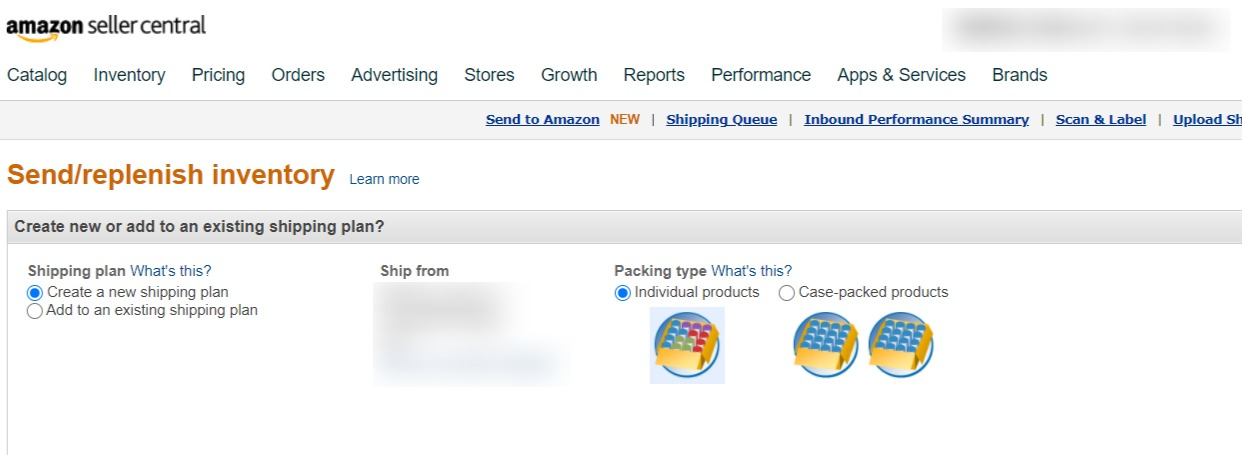
Above: New Shipment Creation Dashboard
- Sellers are supposed to prepare the products and boxes for shipment only after the shipment has been created. This is because Amazon may split the shipment into smaller ones that get sent to more than one warehouse. Sellers can opt-out by choosing Inventory Placement Service but in this case, a per-item service fee applies – when the shipment arrives, it is split up and sent to different fulfillment centers for you.

- 3P sellers can use Amazon partnered carriers at discounted rates or choose a carrier of their preference
- After completing the shipment in Seller Central, the most important part is to put the proper labels on each of the boxes. Making a mistake here can delay the receiving process or even result in a shipment being returned to you because it was sent to the wrong warehouse
Vendor Central
Shipping products to Amazon for vendors is slightly more complicated than for 3P accounts:
- Firstly, vendors rely on Amazon POs which normally get released on Mondays, and there’s a tight shipping window that needs to be followed
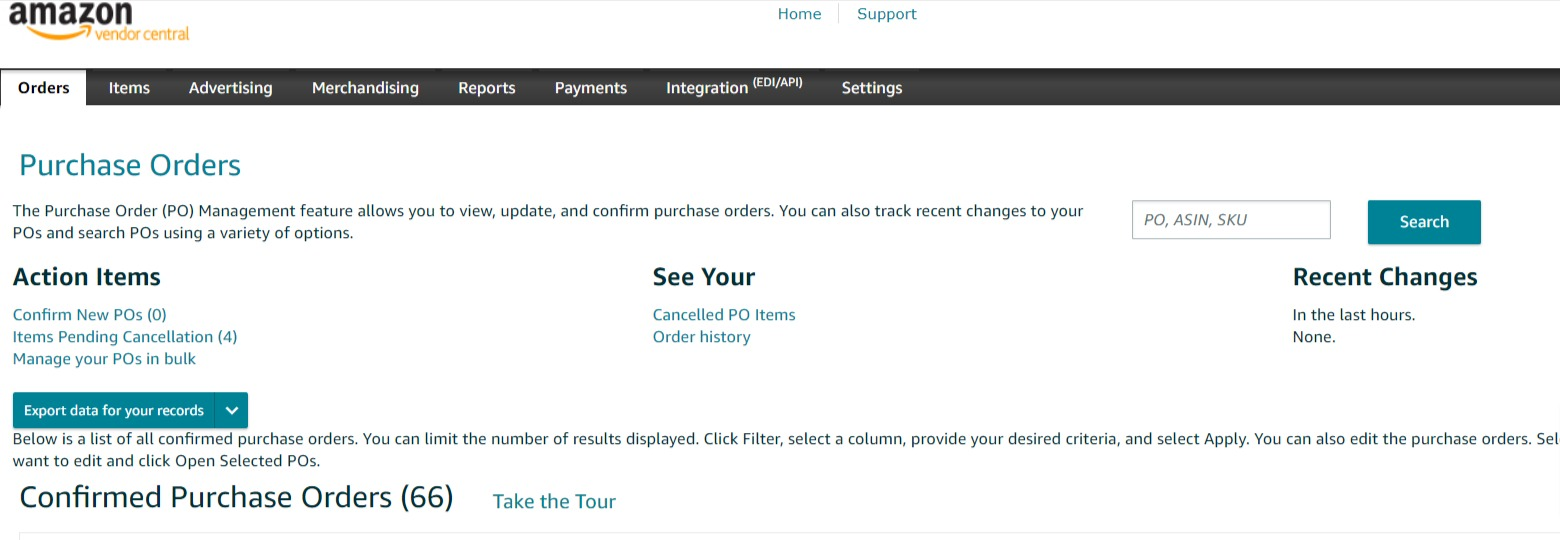
Above: Purchase Orders Dashboard
- Another difference with vendors is that shipping can be collect (within vendor terms and normally 3% of shipped COGS) or prepaid (vendor chooses the carrier)
- An extra layer of complexity for vendors surrounds routing requests and the timely submission of advance shipping notifications. If there are mistakes this will result in chargebacks

Above: Vendor Central Shipments Dashboard
How to inventory forecast and replenish inventory on Amazon
Seller Central
3P accounts have another advantage when it comes to inventory management – they have (almost) full control of what they’re sending to FBA, and when they send it:
- 3P sellers can use Amazon’s internal forecasting tools to gain inventory replenishment insights, but these aren’t always accurate
- The best approach is to combine Amazon’s recommendations with your own forecast based on 30-day velocity for each product, also taking into account any holidays or marketing efforts you’ll be making that may impact demand (deals, social media campaigns, email blasts, etc.)
- One of the biggest struggles with Seller accounts can be inventory quantity limits that prevent sellers from sending the amount they feel provides adequate coverage. The best solution to mitigate this is to have your own fulfillment as a Plan B while Amazon learns more about the demand of your products and increases inventory caps. Another solution is to replenish inventory as often as possible in the early stages of the product launch and waiting for Amazon’s system to increase the inventory limit over time
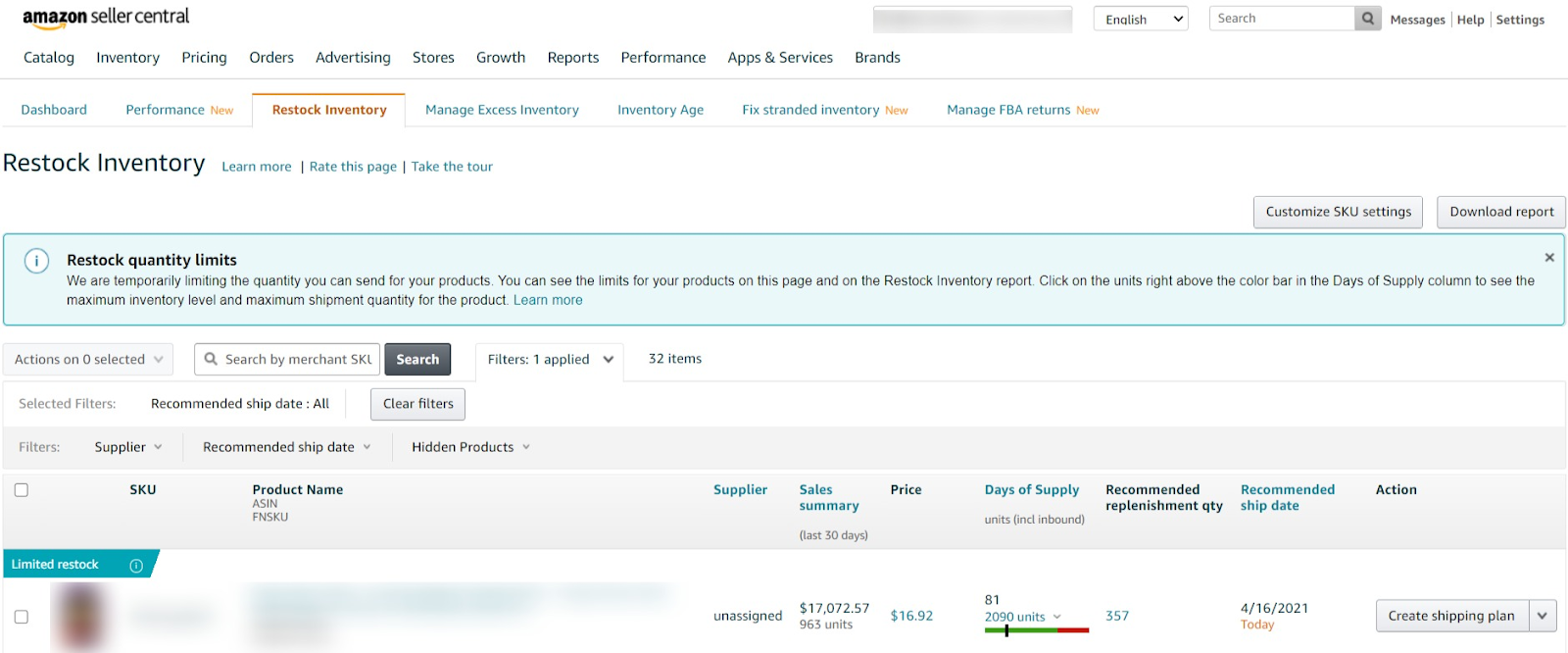
Above: Amazon’s restock inventory dashboard
Vendor Central
For vendor accounts, POs from Amazon can often be inconsistent and it’s a challenge for many vendors to forecast properly:
- The Born to Run program is one of the tools most vendors have at their disposal and it enables them to issue POs on their own. However, if products are not sold within 10 weeks, the vendor needs to choose to either provide a 25% discount or pay for shipping cost to return the overstock

Above: Vendor Initiated Orders (Born To Run) Dashboard
- Looking at forecast reports in Analytics can help vendors have a rough idea of what to expect in their next POs. However, the forecast Amazon provides is often inaccurate
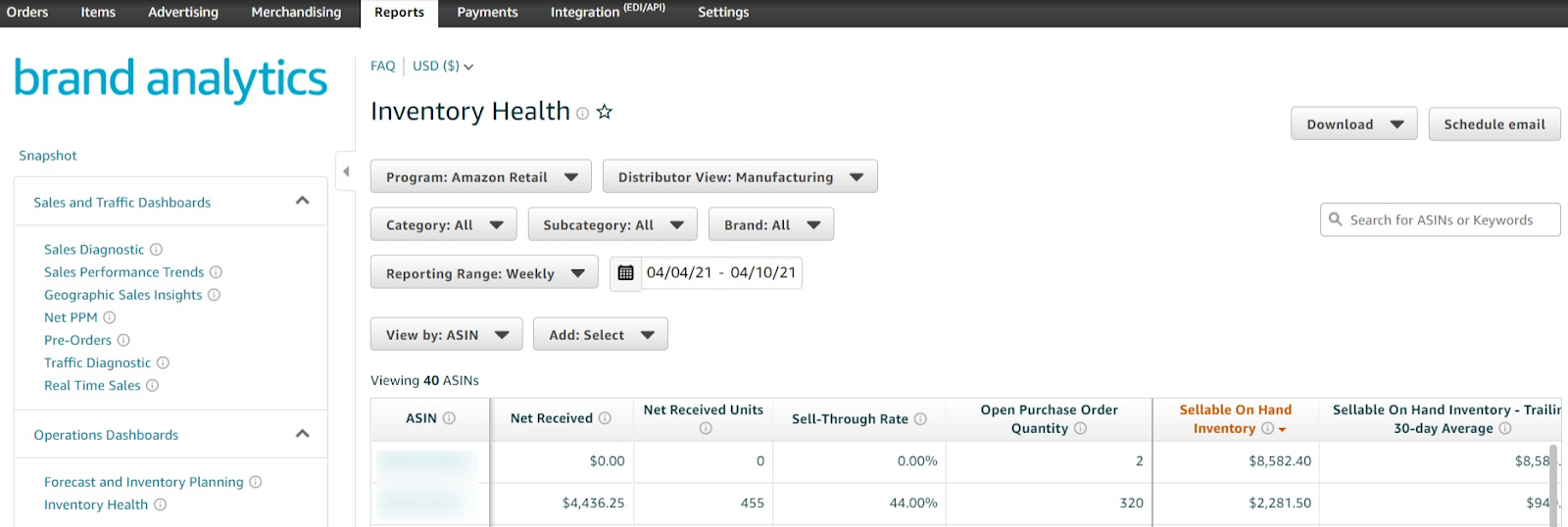
Above: Inventory Health Dashboard
- In an ideal world, Amazon should never order less than what their P90 forecast says

Above: Forecast and Inventory Planning – P90 Forecast Dashboard
Check out Winning Strategies for Amazon Inventory Management
Dealing with refunds and returns
Seller Central
3P sellers again have an advantage over 1P because they have full access to their refund and return data:
- This data can be analyzed and if root causes are found, sellers can work on fixing the issues or minimizing the impact on their Amazon business
- 3P sellers can also interact with Amazon customers through the messaging portal and gain valuable insights this way


Above: Returns Dashboard/Report
Vendor Central
Vendors normally don’t have access to returns unless their agreement with Amazon is to authorize and process this type of inventory:
- The vendor will normally have a damage allowance of between 2-5% of their shipped COGS to enable Amazon to cover the cost of damaged and returned goods
- If Amazon starts being unprofitable with the current DA %, they are very likely to negotiate a higher fee in the next round of vendor negotiations. It is crucial for vendors to ask for data to confirm high return rate or high damage before agreeing to Amazon’s terms
Check out What a High Product Return Rate Means on Amazon
How to dispute unfair Amazon fees and maintain optimal channel profitability
Seller Central
Yet another advantage of 3P over 1P – sellers control their selling prices and simply bumping up the price can improve channel profitability:
- Sellers should also audit the fulfillment fees and returns and ask for reimbursements from Amazon if specific orders have incorrect fees or when specific returns were not refunded as per Amazon’s Seller policy
- Having almost full control over inventory in Seller Central is also advantageous because sellers can optimize the levels of inventory they have at FBA, thus controlling the storage fees

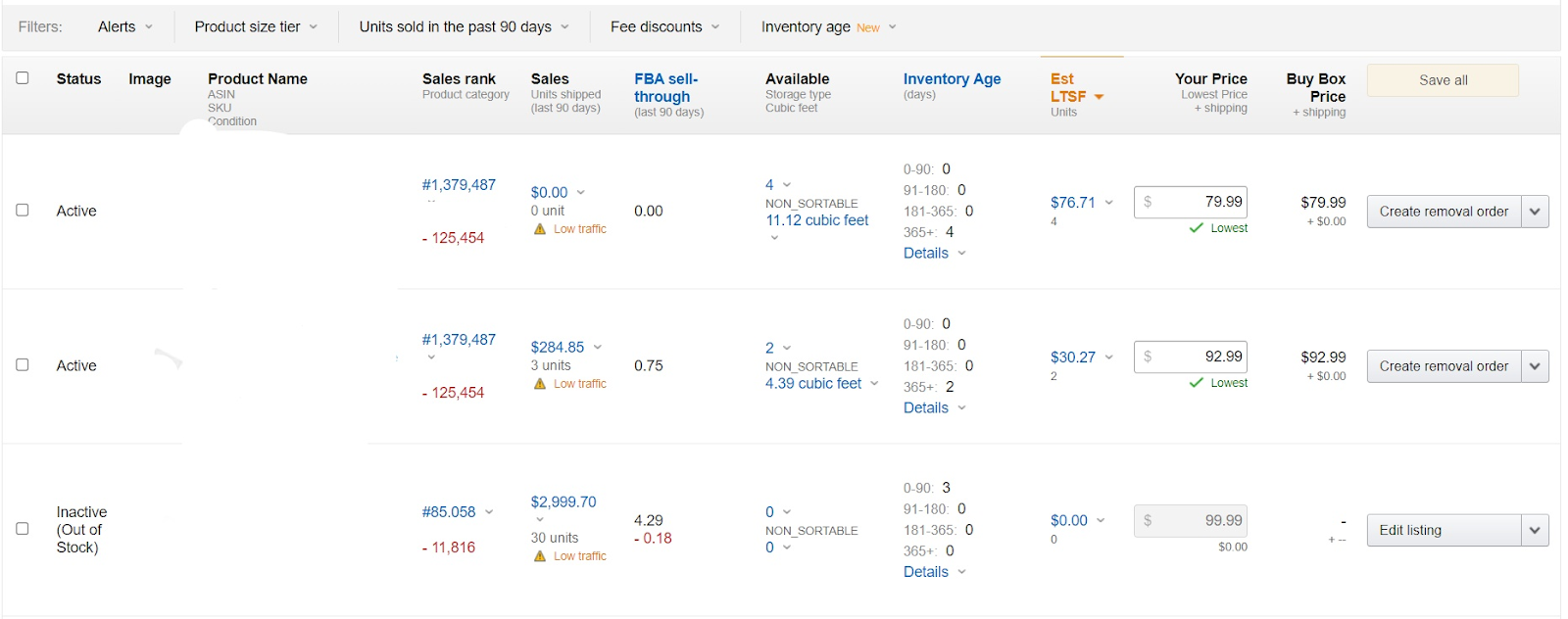
Above: Inventory Age Dashboard
Vendor Central
Remaining profitable on Amazon is an ongoing battle for Vendors due to ever-increasing fees and the fact each mistake is penalized in a form of chargeback:
- The most important thing for vendors to focus on is operational excellence so there are no additional costs of doing business with Amazon. The following dashboards within Vendor Central should be reviewed regularly, and if there are discrepancies, they should be thoroughly investigated.

Above: Operational Performance Dashboard
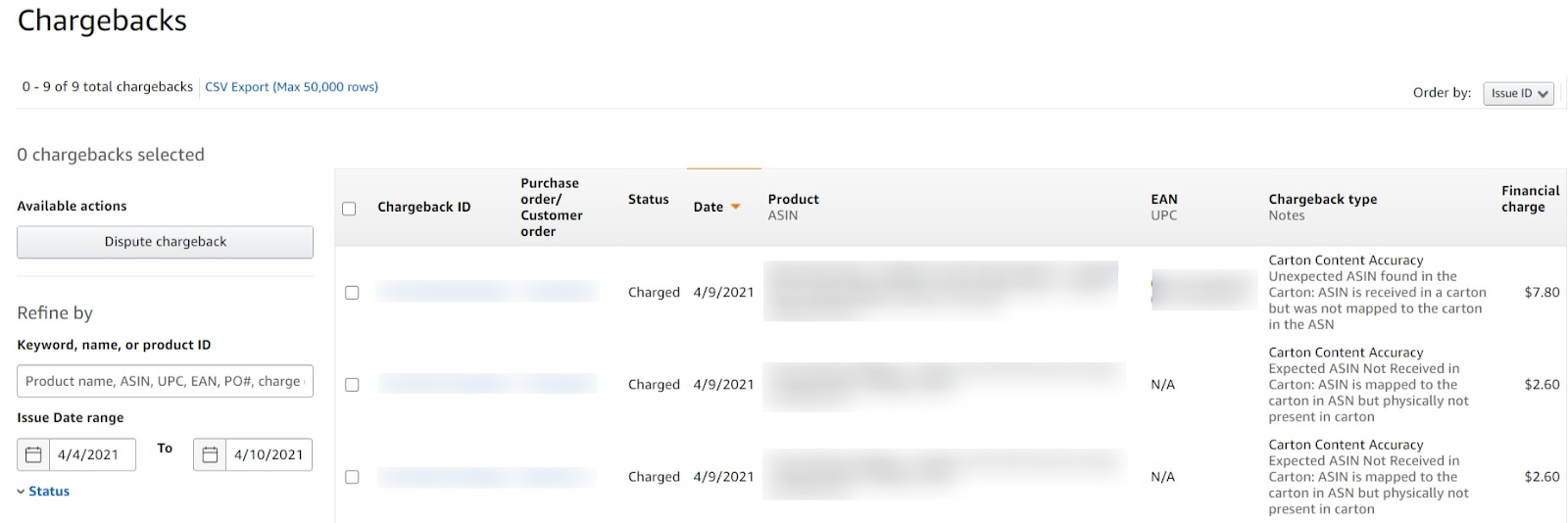
Above: Chargebacks Dashboard

Above: Invoices Dashboard

Above: Shortage Invoice Dashboard

Above: Dispute Management Dashboard
- Additionally, vendors need to be prepared to dispute chargebacks and shortages by having proper documentation and processes in place. Learn more – Understanding Vendor Chargebacks
Need help with Supply Chain and Logistics for Amazon?
Book a free consultation with one of our experts today!
{{cta(‘0825dfed-dfd0-4c96-bfc0-9b14009fed23’)}}


